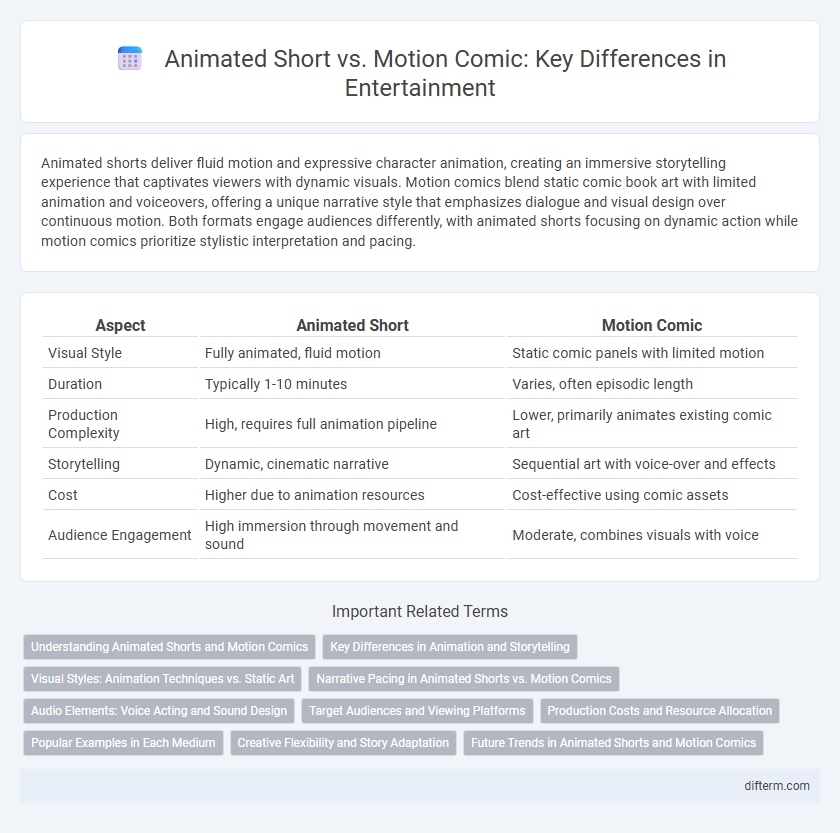Animated shorts deliver fluid motion and expressive character animation, creating an immersive storytelling experience that captivates viewers with dynamic visuals. Motion comics blend static comic book art with limited animation and voiceovers, offering a unique narrative style that emphasizes dialogue and visual design over continuous motion. Both formats engage audiences differently, with animated shorts focusing on dynamic action while motion comics prioritize stylistic interpretation and pacing.
Table of Comparison
| Aspect | Animated Short | Motion Comic |
|---|---|---|
| Visual Style | Fully animated, fluid motion | Static comic panels with limited motion |
| Duration | Typically 1-10 minutes | Varies, often episodic length |
| Production Complexity | High, requires full animation pipeline | Lower, primarily animates existing comic art |
| Storytelling | Dynamic, cinematic narrative | Sequential art with voice-over and effects |
| Cost | Higher due to animation resources | Cost-effective using comic assets |
| Audience Engagement | High immersion through movement and sound | Moderate, combines visuals with voice |
Understanding Animated Shorts and Motion Comics
Animated shorts deliver visually rich, standalone stories using frame-by-frame animation and dynamic motion, often created for film festivals or online platforms. Motion comics blend static comic art with limited animation, voiceover, and sound effects to create a narrative experience that bridges traditional comics and animation. Both formats engage audiences uniquely, with animated shorts emphasizing fluid storytelling and motion comics leveraging graphic novel aesthetics enhanced by multimedia elements.
Key Differences in Animation and Storytelling
Animated shorts feature fluid, frame-by-frame animation that brings characters and scenes to life with dynamic movement and expressive detail. Motion comics combine static comic panels with limited animation, voiceovers, and sound effects to create a hybrid visual storytelling experience. The key difference lies in animation complexity and narrative pacing: animated shorts emphasize continuous motion and rich visual storytelling, while motion comics focus on enhancing static art with audio and minimal animation to convey the story.
Visual Styles: Animation Techniques vs. Static Art
Animated shorts utilize fluid frame-by-frame animation techniques to create dynamic, lifelike motion and expressive character performances, enhancing viewer immersion. Motion comics combine static comic art with limited animation elements like panning, zooming, and speech bubbles, preserving the original illustrative style while adding minimal movement. The visual style of animated shorts emphasizes seamless animation sequences, whereas motion comics rely on artistic panels augmented by subtle motion effects to maintain narrative pacing.
Narrative Pacing in Animated Shorts vs. Motion Comics
Narrative pacing in animated shorts is typically faster, utilizing fluid motion and dynamic scene changes to convey story progression efficiently within a limited timeframe. Motion comics rely on a more deliberate pacing, combining static images with minimal animation, which allows for detailed storytelling but can result in slower narrative momentum. The difference in pacing impacts viewer engagement, with animated shorts often delivering a more immediate and immersive experience compared to the episodic and contemplative style of motion comics.
Audio Elements: Voice Acting and Sound Design
Animated shorts employ dynamic voice acting with nuanced emotional delivery, complemented by immersive sound design that enhances visual storytelling. Motion comics rely on static images paired with voice narration and selective sound effects to create an engaging auditory experience without full animation. Superior audio elements in animated shorts often contribute to a richer sensory impact compared to the more minimal soundscapes in motion comics.
Target Audiences and Viewing Platforms
Animated shorts primarily attract younger audiences seeking dynamic, visually engaging storytelling on platforms like YouTube and streaming services such as Netflix Kids. Motion comics appeal to niche adult fans of graphic novels and comic culture, often accessed through digital comic apps and specialized websites. Both formats cater to different consumption habits, with animated shorts favoring quick, immersive viewing and motion comics focusing on interactive, paced narrative experiences.
Production Costs and Resource Allocation
Animated shorts generally require higher production costs due to frame-by-frame animation, detailed character design, and fluid motion, demanding larger teams of animators, voice actors, and post-production specialists. Motion comics utilize static artwork with minimal animation and limited voice-over, significantly reducing labor and resource allocation while allowing faster turnaround times. Budget-sensitive productions often favor motion comics as an efficient alternative to full animation without sacrificing narrative depth.
Popular Examples in Each Medium
Animated shorts such as Pixar's "Bao" and Disney's "Paperman" showcase high-quality storytelling and fluid animation that captivate wide audiences. Motion comics like Marvel's "Spider-Woman" and DC's "Injustice: Gods Among Us" blend comic book art with limited animation, appealing to fans of graphic novels seeking dynamic but cost-effective narratives. Both mediums utilize distinct visual techniques to engage viewers, with animated shorts offering cinematic experiences and motion comics providing a hybrid storytelling format.
Creative Flexibility and Story Adaptation
Animated shorts offer extensive creative flexibility through fully customizable visuals, dynamic character movements, and fluid scene transitions, enabling storytellers to craft immersive worlds and emotionally impactful narratives. Motion comics blend static comic art with limited animation and voiceovers, providing a cost-effective way to adapt graphic novels while preserving original artwork and pacing. The choice between the two depends on budget, desired storytelling depth, and the level of visual dynamism needed to enhance audience engagement.
Future Trends in Animated Shorts and Motion Comics
Future trends in animated shorts emphasize immersive storytelling through advanced CGI and real-time rendering, enhancing visual fidelity and audience engagement. Motion comics are increasingly integrating interactive elements and AR technology, creating hybrid experiences that blend static art with dynamic motion, appealing to digital-native viewers. Both mediums leverage AI-driven content creation and personalized narratives to redefine entertainment consumption.
animated short vs motion comic Infographic

 difterm.com
difterm.com